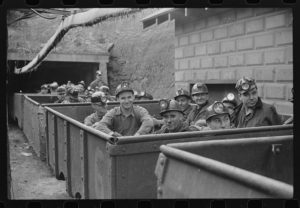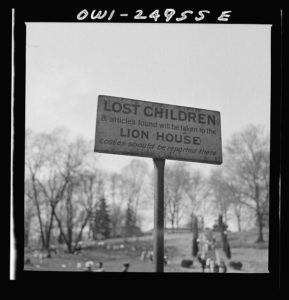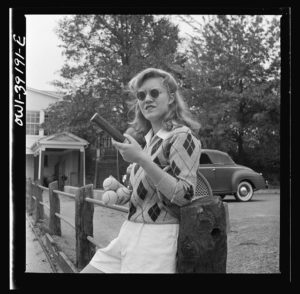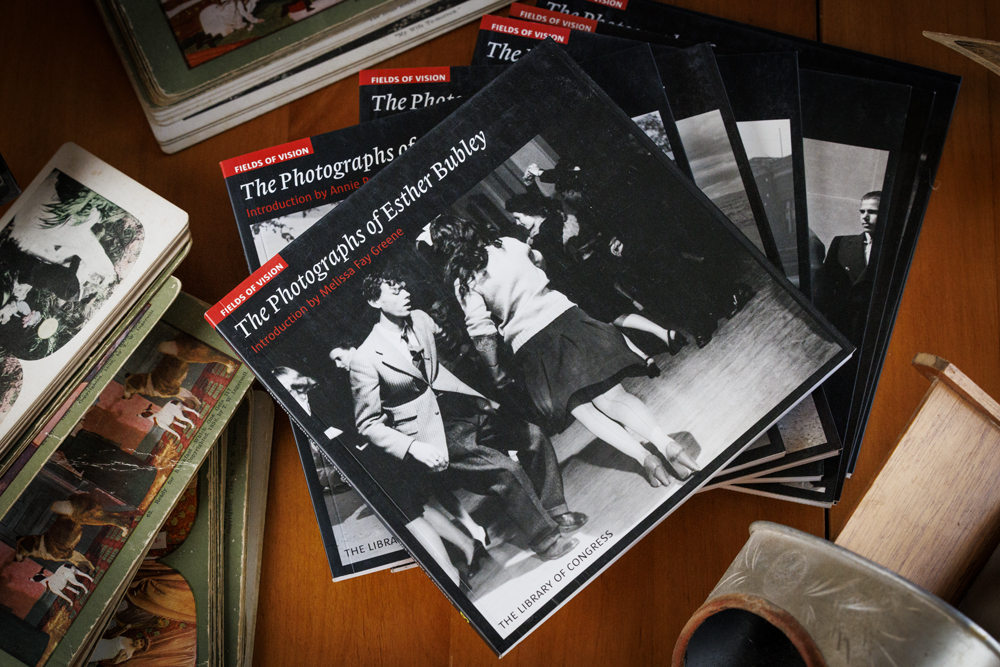Esther Bubley and Marion Post Wolcott: The FSA-OWI Photographs
Chances are, if you know anything about the Farm Security Administration or its successor agency, the Office of War Information, it’s likely to be because of Dorothea Lange’s “Migrant Mother” portrait, the iconic image of a mother waiting with her children at a migrant workers’ camp while her husband is in town getting parts to repair their car.
Lange’s photograph has been cited as likely the most well-known photograph ever and Lange’s body of work has earned her a well-deserved spot in most histories of photography. But she was not the only woman to work for the Farm Security Administration.
Two of her fellow photographers, Marion Post Wolcott and Esther Bubley, today balance on the edge of obscurity to most Americans, despite producing impressive and significant images for the FSA and OWI.
Fields of Vision
Fortunately, the Library of Congress, through their Fields of Vision books has given us affordable and well-printed volumes on Post Wolcott and Bubley, as well as most of the other FSA photographers (see my discussion of Gordon Parks and his work for the FSA). And, while the book series was first published more than 10 years ago, the volumes featuring Post Wolcott and Bubley, as well as some of the other FSA photographers, remain available on Amazon.
Marion Post began working for the Farm Security Administration in 1938 and remained at the agency until February, 1942. Esther Bubley joined the FSA’s successor agency, the Office of War Information in the fall of 1942.

Dramatic Changes in America
How rapidly and dramatically America changed in the years between when Post Wolcott began her work for the FSA and when Bubley began photographing for the Office of War Information can be seen when looking at the pictures in the two Fields of Vision volumes.
Post Wolcott’s images of West Virginia coal miners crowded into ore cars headed into the mines give way to Bubley’s photographs of teenagers jitterbugging, playing tennis and sun bathing by the pool in Maryland.
Post Wolcott showed us striking copper miners waiting for scabs to emerge from the mines in Tennessee and farm workers crammed onto a decrepit wagon coming back from getting groceries and supplies. Bubley captured a snappily-dressed young cadet at a regimental ball at Woodrow Wilson High School in Washington.

Almost everywhere In Bubley’s photographs there are uniforms. We glimpse through the curtains of a picture booth to see a man in uniform. Two soldiers, one Black and one white, peer out of a Greyhound bus window. Another soldier, who looks barely old enough to shave, leans against a poster outside a movie theater in Washington. Two soldiers and their girlfriends pause before the men board a Greyhound bus.
In the Post Wolcott book, a photograph of a “mountain woman” in Kentucky is paired with a picture on the opposite page of a “Farm Security Administration borrower” and his two children in Montana. Though the subjects are half a country apart, in both photographs you can almost feel the sun beating down on them. It’s that same, harsh sunlight that we’ve come to associate with the dustbowl. One expects to see Tom Joad coming around the corner at any minute.
Documenting the Jim Crow Era
But, it’s also painfully clear that for a least one group of Americans, not much changed between Post Wolcott’s work and Bubley’s.

One of Post Wolcott’s most powerful and favorite images is titled, “Man going in colored entrance of movie house on Saturday afternoon, Belzoni, Mississippi Delta, Mississippi, c. October 1939”
The lighting is harsh and the dark diagonal line formed by the stairway cuts the image nearly in two. The man is in shadow and stands about a third of the way up the staircase. He is directly underneath a Dr. Pepper sign painted on the brick wall, while an arrow follows the angle of the stairway, reading “Colored • Adm. 10¢”
Bubley’s Greyhound Bus photos includes a simple sign she photographed while traveling from Louisville, Kentucky, to Memphis, Tenn. It reads “Colored” in all caps and large print with an arrow below that reads “waiting room.”
There is a rest stop that Bubley photographed during a bus trip from Louisville to Nashville. The “rest stop” is nothing more than a large outhouse with two doors, one reading “Men.” Between the two doors, is painted “Colored Dining Room in Rear.” Is the “dining room” actually attached to the back of the outhouse? That seems all too likely to have been the case in the Jim Crow south.
Humor in Their Photos

There are flashes of humor in the photographs, as in Bubley’s photograph of a sign at the National Zoo, the reads, “Lost Children and articles found will be taken the Lion House.” Post Wolcott’s deadpan image “Guests of Sarasota trailer park picnicking at the beach, Sarasota, Florida” shows two women and a man, seated on the running board of a sedan, while a third woman stands to the left. All are dressed in long overcoats, hats and shoes. Before the sitting threesome is a folding table with a picnic basket. The image could easily be mistaken for a Lee Friedlander, Elliott Erwitt or, if it were in color, a Martin Parr.
Marion Post Wolcott
Marion Post was born in Bloomfield, New Jersey in 1910. Her father was a physician, which afforded the family an upper middle-class lifestyle. But her upbringing was less than idyllic. Her father was unfaithful and her mother rebelled against the confines of suburban life. When Marion was 13 her parents divorced.

She and her older sister, Helen, received scholarships to a progressive boarding school in Greenwich, Conn. Their mother moved to Greenwich Village in New York, where they spent weekends and summers attending the theater, art exhibitions and just socializing with their mother’s non-conformist circle of friends.
Vienna Before World War II
After attending the New School for Social Research and New York University, Marion Post took a teaching job in Massachusetts. When her father died in 1932, Marion used a modest inheritance to continue her education in Vienna, where her sister was studying with photographer Trude Fleischmann.
Marion bought a small Rolleiflex camera and also took up photography. But, with rising Nazism and the increasing persecution of their Jewish friends in Vienna, the two decided to leave Europe.
Back in the states, Marion shared an apartment in Manhattan with Helen and began attending meetings of the Photo League, a group of socially conscious photographers that included Paul Strand among its driving forces, along with the filmmaker Ralph Steiner.
Covering the “Women’s Beat”

She found work with the Philadelphia Evening Bulletin, but became bored with being relegated to covering the “women’s beat.” At the Photo League, Steiner was impressed with Post’s work and recommended her to Roy Stryker, head of the photography division of the Farm Security Administration.
She went to work for the FSA, becoming the first full-time woman photographer (Lange worked for the FSA, but as a part timer).
Marion’s first assignment was in the coal fields of West Virginia. On assignment for the FSA, Post traveled alone throughout much of the country, often following a brutal schedule with little time off.
In April 1941 she met Lee Wolcott, a widower with two children and an assistant to Roosevelt’s Secretary of Agriculture, Henry Wallace. They quickly fell in love and were married in June. Post Wolcott had long felt underappreciated and disillusioned with what she saw as unequal treatment in comparison with the male photographers at the FSA.

Leaving the FSA
With war fast approaching, with a new husband and two step-children and a desire to have children of her own, she was confronted with a new FSA assignment that would demand extensive time on the road away from her husband and family. Feeling as though her work would never receive recognition and she would not be assigned the projects granted to male FSA photographers, Marion Post Wolcott decided to leave the agency and effectively retire from photography.
Tension was high between Stryker and Lee Wolcott, with Lee Wolcott even suggesting that Stryker should be fired for his treatment of Marion. In the end, he had to settle for forcing Stryker to change all the credits on Marion’s photographs from Marion Post to Marion Post Wolcott.
In February, 1942, Marion Post Wolcott left the FSA and retired from professional photography. She did not stop taking photographs, but in a 1965 interview she listed a series of life pressures and events that led to her decision to give up professional photography.
No Time for Professional Photography
“I ‘inherited’ two children, and the war, and living in the country, a subsistence kind of living in the country, and victory gardens, and no help, and that kind of thing. And then we went from that to a much larger farming proposition and I had two children of my own, which made four altogether, and we remodeled the houses that we moved into, and the farms.”
In 1953, Lee Wolcott was injured in a farm accident that badly burned his legs, hospitalized him for five months and led them to quit farming. They moved to New Mexico, where he taught government at the University of New Mexico. Lee worked for the State Department from 1959 to 1968, which took them to Iran, Afghanistan, Pakistan, India and Egypt. Unfortunately, just before they were evacuated from Egypt during the Seven Days War in 1967, she destroyed nearly all of her personal archive to save it from capture. They returned to the U.S. and in 1968 settled in Santa Barbara, California.
Rediscovered in the 1960s and 1970s
Post Wolcott began documenting the counter-culture while working as a docent at the Santa Barbara Museum. She became active in the Santa Barbara and San Francisco art communities and met photographers Judy Dater and Jack Welpott (who were married at the time). They helped her secure a show in New York and she borrowed her negatives from the Library of Congress and supervised the printing of her photographs. In the 1980s she donated her personal papers and photographs to the Center for Creative Photography in Tucson, Arizona.
Lee Wolcott died 1997 and Marion, after a long battle with lung cancer, died on November 24, 1999.
Esther Bubley
While Marion Post Wolcott cut her professional photography career short in favor of marriage and family, Esther Bubley took a different route. Nearly 11 years younger than Post Wolcott, Esther Bubley began working at the FSA’s successor agency, the Office of War Information, first as a darkroom assistant. Post Wolcott had already left the FSA, so they never worked together.

If Post Wolcott chafed at the treatment she received, Bubley seemed to flourish in the environment, although her tenure was brief.
Covering the Home Front
Roy Stryker tested her out with a photo essay about her sister Enid’s boardinghouse in Washington, D.C. As the U.S. embarked on World War II, young women were flocking to Washington to fill jobs created by the war effort. It was the kind of assignment that the OWI wanted covered, documenting how the war was impacting and changing daily life.
Impressed with her work, Stryker took her out of the darkroom and made her a field photographer. Bubley didn’t drive, so she was assigned to travel across country by bus for six weeks, documenting the transition from Depression to wartime economy.
The quiet, unobtrusive girl Jewish girl from Phillips, Wisconsin, had a remarkable ability to blend in and put her subjects at ease. Her parents had emigrated from Latvia and Lithuania. Their home towns were both under Russian control at the time. A half-century after they left, most of the Jewish citizens of their native villages were rounded up and killed.
Inspired by Life

Esther was the fourth of five children and the youngest girl in the family. She and her brother Stanley became interested in photography and when Life Magazine hit the newsstands for the first time in 1936, Esther Bubley, the editor of her high school yearbook, emulated the magazine’s design and realism.
She graduated early from high school, spent two years in teacher’s college, one year working at a photo finishing lab in Duluth, Minnesota and one year studying photography at the Minneapolis School of Art.
She could not find a job in photography in Minneapolis, so she joined her sisters Enid and Claire in Washington, D.C., where Enid was a nurse and Claire a court reporter. Unable to find work in Washington, she tried New York, where she had brief jobs taking pictures at a nightclub and photographing gifts for a Vogue Christmas issue.
She returned to Washington in 1942, taking a job microfilming documents for the National Archives. Her supervisor was a friend of Stryker and, realizing that she was overqualified for the job, he encouraged Stryker to interview her.
A Successful Free Lance Career
Entering the world of photojournalism, Bubley never looked back. More staff assignments for the OWI followed and then when Stryker left the OWI for a public relations project for Standard Oil of New Jersey, he took her, along with several other FSA/OWI photographers including Gordon Parks and John Vachon.
Bubley married Stryker’s assistant, Edwin Locke, in 1947 and then quickly divorced. While working on the Standard Oil project, Esther again hit the road via bus, producing another “Bus Story” that won the award for Best Picture Sequence in the 1948 Encyclopedia Britannica/University of Missouri “New Pictures of the Year” contest.
Bubley enjoyed a successful career as an assignment photographer, working for Life, Saturday Evening Post, Look, Ladies Home Journal, Harper’s Bazaar, McCalls and other publications, along with government, businesses and social service agencies. Her assignments took her around the world and she was included in the famous “Family of Man” exhibition for the Museum of Modern Art.
By the late 1960s, as the golden era of photojournalism waned, she reduced her assignments, but continued to photograph, producing two children’s books and a book featuring her macro photography of plants. Like Post Wolcott she developed cancer and died in New York City in March 16, 1998, just over a year and half before Post Wolcott died in California.
Fields of Vision page on Amazon
Marion Post Wolcott, Fields of Vision on Amazon
Esther Bubley, Fields of Vision on Amazon
Using these Amazon links when buying books helps support this website. Thank You!
